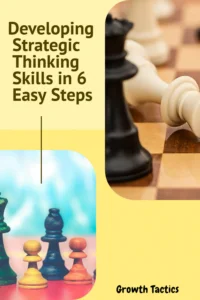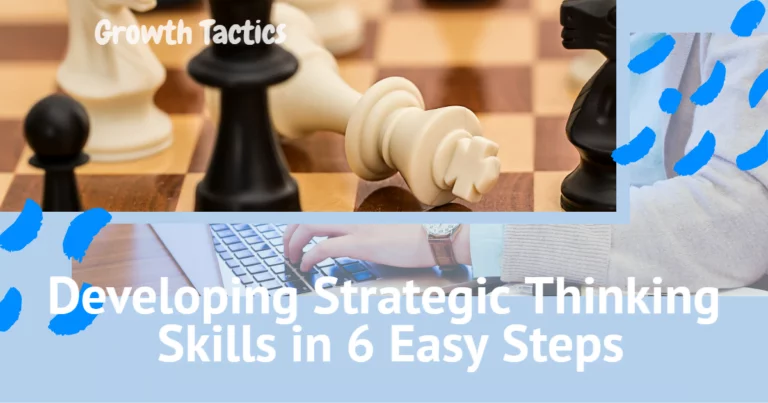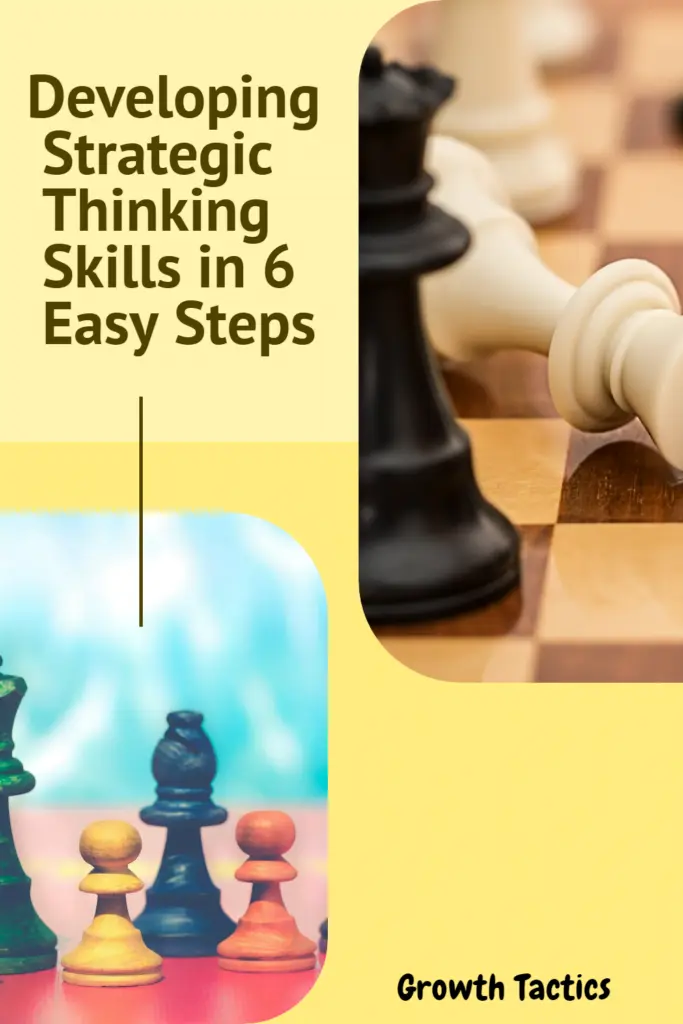Strategic thinking is the ability to develop a vision, set goals, analyze competitive dynamics and market trends, and make plans to achieve long-term business objectives. It involves evaluating various options and scenarios to determine the best path forward.
Strategic thinking differs from strategic planning. Strategic planning is focused on developing detailed, structured plans to reach goals. Strategic thinking is about taking a big picture, future-oriented perspective to spot patterns, opportunities, and challenges. It requires an open, creative mindset.
Strategic thinkers have certain traits that enable them to effectively analyze situations and develop successful strategies:
- They take a broad, systems-level perspective, seeing how different parts of the business fit together.
- They anticipate future trends and changes in the market environment.
- They can identify the key issues and variables that will impact the strategy.
- They consider diverse options and scenarios.
- They make decisions today with tomorrow in mind.
- They balance intuition with analysis to develop visionary yet realistic strategies.
- They involve stakeholders, listen well, and communicate strategic thinking effectively.
In this article, we are going to discuss ways of developing strategic thinking skills in yourself and others.

Jump To Section
Why Develop Your Strategic Thinking Skills?
Improving your strategic thinking skills provides immense benefits for business leaders and professionals. By developing your strategic thinking abilities, you gain a competitive advantage and are able to make better decisions that align with long-term goals.
As a leader, strategic thinking enables you to analyze competitive forces and trends to determine the best positioning and plans for your organization. It helps you recognize opportunities and threats earlier and respond effectively. With strategic thinking, you can craft innovative strategies and business models that disrupt markets and attract customers.
For business professionals, improving strategic thinking skills allows you to provide more value in your role. You’re able to connect activities and tasks to larger organizational objectives. During planning or decision-making, you can offer creative solutions or recommendations. Your foresight and critical thinking help the organization prepare for future challenges and opportunities.
Overall, strategic thinking skills empower leaders and professionals to drive growth, innovation, and success. The ability to think strategically is essential for navigating today’s complex and fast-changing business landscape. By developing a strategic mindset, you gain a lasting competitive advantage.
How to Cultivate a Strategic Mindset
Strategic thinking requires the ability to take a big-picture view of a situation or challenge. Leaders with strong strategic thinking skills can anticipate changes and shifts that may impact their organization or industry. They ask insightful questions to understand different perspectives and weigh various options when making decisions.
To cultivate a more strategic mindset:
- Look beyond immediate issues and goals to consider the broader context and impact of decisions. Take time to analyze industry trends, competitive forces, and potential disruptions that could influence your business.
- Anticipate change by considering different scenarios and how your plans and strategies might need to adapt. Challenge assumptions and conventional thinking.
- Ask probing questions to understand different viewpoints and identify blind spots. Discuss scenarios with colleagues to gain diverse perspectives.
- Weigh options and make decisions not just based on static data, but also considering uncertainties, risks, and how the situation could evolve. Evaluate both short-term and long-term impacts.
- Visualize future possibilities and formulate plans to capitalize on emerging opportunities or mitigate potential threats.
Taking a big-picture perspective, anticipating change, asking questions, and evaluating options are key habits that help leaders develop a more strategic mindset. This mindset allows them to navigate uncertainty and position their organizations for future success.
Practice Scenario Planning
Strategic thinkers imagine different potential futures or scenarios that could unfold and prepare for various outcomes. This involves envisioning multiple “what if” situations, anticipating potential challenges or roadblocks, and adapting plans as needed.
Scenario planning boosts strategic agility and flexibility. By imagining different versions of the future, you can identify risks, generate contingency plans, and respond swiftly to changing conditions. For example, a business leader might envision scenarios like “What if a new competitor enters the market” or “What if there is an economic recession”.
To apply scenario planning:
- Brainstorm various scenarios, including best-case, worst-case, and moderate outcomes
- Analyze the key factors that would lead to each scenario
- Assess the likelihood of each scenario occurring
- Develop plans and strategies to address each potential scenario
- Identify signposts to monitor if a scenario is emerging
- Remain flexible and ready to update plans as the future unfolds
Regularly practicing scenario planning strengthens strategic thinking muscles. It enables rapid adaptation when the real world diverges from initial expectations. With an agile mindset and contingency plans in place, you can turn unexpected developments into opportunities.
Develop Systems Thinking
Systems thinking is a key component of strategic thinking. It involves understanding how various parts of a system influence and interact with each other. To think systematically, you need to take a holistic view and recognize connections between different elements.
For example, in a business setting, you may need to consider how a new product launch could impact manufacturing, marketing, sales, customer support, and finance. Changing one area often causes ripple effects across the entire organization. Systems thinkers can anticipate these chain reactions and plan accordingly.
You can improve your systems thinking abilities by:
- Mapping out all the stakeholders, departments, and resources connected to a strategic initiative. This helps you see the big picture.
- Identifying inputs and outputs for key processes. Recognize how the output of one process becomes the input for another.
- Tracing the potential impact of a decision throughout the system. Ask yourself “if we do X, what might happen to A, B, and C downstream?”
- Finding the leverage points where a small shift can create big changes. Systems often have key pressure points.
- Recognizing delays and feedback loops. There may be time lags between causes and effects.
- Seeing yourself as part of the system. Consider how your own actions and beliefs influence the system.
The more you can strengthen your systems thinking perspective, the better you’ll be able to develop strategies that align with realities on the ground. You’ll prepare for unintended consequences and handle complex challenges more effectively.
Improve Decision-Making Skills
Making good decisions is a critical component of strategic thinking. When facing a decision, strategic thinkers weigh the pros and cons, consider unintended consequences, and evaluate the risks versus rewards.
Some tips for improving your decision-making skills:
- Clearly define the decision you need to make. What is the goal you want to accomplish or the problem you want to solve?
- Develop a list of options. Use your knowledge of the business, the situation, and stakeholders to brainstorm possible choices.
- Analyze each option. Look at the upsides and downsides. Identify risks and unknowns associated with each one.
- Make the decision. Based on your analysis, choose the option that you believe best balances risk and reward.
- Anticipate challenges. Think about what could go wrong when executing this decision. Develop contingency plans.
- Be willing to update your choices. If new information arises, re-evaluate your decision. Make changes if needed.
- Accept that you won’t know the consequences of every decision until later. Focus on making the best decision you can with the information available.
Slowly but surely developing your decision-making skills will enable you to make difficult strategic choices with greater confidence. Weighing options thoroughly and anticipating potential pitfalls will serve you well.
Ask Insightful Questions
Strategic thinkers are inquisitive and ask thoughtful questions to gain deeper insight. Asking open-ended questions allows you to challenge assumptions and dig deeper into issues. Some examples of insightful questions include:
- What factors could disrupt our plans?
- How might this decision impact other parts of the organization?
- What trends could influence this situation in the future?
- What other perspectives or approaches could we consider?
- What unintended consequences could result?
- What are we overlooking or what don’t we know?
- What alternatives or options haven’t been explored?
- What evidence do we need to validate key assumptions?
- How might customers or stakeholders react?
- What could go wrong and how could we prevent or address it?
Continuously asking probing questions allows you to think critically about issues from multiple angles. It also helps identify blind spots, challenges status quo thinking and opens up new possibilities. The quality of the questions you ask determines the insights you gain. Take time to reflect on the right questions before moving forward on key strategic decisions.
Hone Critical Thinking Abilities
Critical thinking is an essential component of strategic thinking. To think strategically, you need to evaluate information objectively and make decisions based on facts rather than emotions or biases.
Some ways to improve your critical thinking skills include:
- Identify logical fallacies. Learn to recognize common fallacies like false dichotomies, straw man arguments, appeals to emotion, etc. Being able to spot faulty logic helps avoid poor reasoning.
- Avoid bias. We all have biases, but strategic thinkers aim to reduce bias when evaluating information and making decisions. Consider perspectives different from your own.
- Evaluate facts objectively. Gather information from reputable sources. Analyze facts on their merits without letting emotions or preconceived notions influence you. Weigh factual evidence fairly.
- Question assumptions. Don’t assume something is true without examining it. Think critically about the assumptions underlying an argument.
- Consider context. To judge information accurately, consider the context. Understanding the circumstances surrounding data allows for better analysis.
- Practice constructive skepticism. Have a questioning mindset, but base your skepticism on logic and evidence, not just doubt for its own sake.
Sharpening your critical thinking abilities takes diligence, but it’s essential for strategic thinking. Analyzing information objectively, identifying faulty reasoning, and questioning assumptions – these skills allow you to make strategic decisions based on facts rather than feelings. With practice, you can hone your critical thinking and avoid poor logic and biased thinking.
Develop Foresight
The ability to anticipate future needs, trends, and changes in the environment is a key component of strategic thinking. Leaders who develop foresight can get ahead of developments in their industry and make proactive moves to prepare their organization for the future.
Some ways to build foresight include:
- Continuously scanning the external environment for signals of change – these could include emerging technologies, shifting consumer preferences, new regulations, etc. Look for patterns and trends.
- Engaging with thought leaders in your industry to exchange perspectives on where things are heading. Attend conferences and events to stay on top of the latest innovations and disruptions.
- Visualizing potential scenarios – imagine how your business and industry might look 5-10 years from now under different conditions. Consider how you would prepare for each scenario.
- Identifying assumptions about the future of your business and actively challenging them. Don’t rely on linear projections.
- Considering “what-if” questions regularly as part of your strategic thinking. What if a new technology emerges? What if a competitor introduces an innovative business model?
- Exploring adjacencies – look at trends in adjacent industries/fields that could impact your own.
By developing your capacity for strategic foresight, you can get ahead of developments, adapt faster to change, and stay competitive in a rapidly evolving business environment. The future rewards those who see it coming.
Practice Strategic Thinking Every Day
Make it a habit to think strategically and apply strategic thinking to all areas of your life and work. Some ways to practice strategic thinking daily include:
- When faced with a decision or challenge, take a step back to consider the big picture and various options. Avoid jumping to conclusions.
- Ask yourself questions like “What factors are driving this situation?” and “What are the possible unintended consequences?” to understand the broader context.
- Discuss your ideas and proposals with others to get different perspectives. Be open to critiques and feedback.
- Look for connections between separate initiatives or developments in your company or industry. Identify patterns and trends.
- Read broadly about your industry, competitors, and global issues. Draw insights by synthesizing information.
- When making plans, develop contingency plans as well. Consider alternative scenarios and have a backup strategy.
- Reflect on your past decisions and analyze why some worked well while others didn’t go as planned. Learn from your mistakes.
- Step into others’ shoes regularly. Consider how your decisions or plans impact different stakeholders.
- Avoid making assumptions. Question them by gathering data, observing, or testing hypotheses.
Making strategic thinking an ingrained habit takes time and conscious practice. But slowly and surely developing your ability to think strategically will lead to better plans, decisions, and outcomes in all aspects of life.


